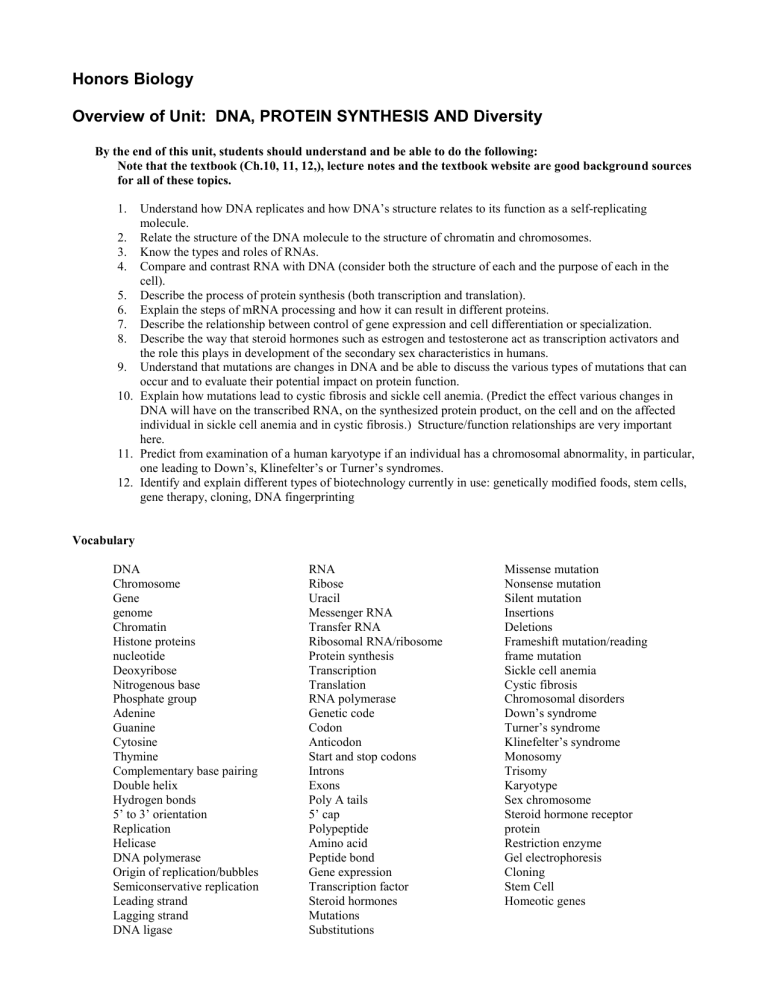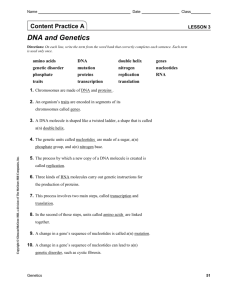Honors Biology - HomeworkNOW.com

Honors Biology
Overview of Unit: DNA, PROTEIN SYNTHESIS AND Diversity
By the end of this unit, students should understand and be able to do the following:
Note that the textbook (Ch.10, 11, 12,), lecture notes and the textbook website are good background sources for all of these topics.
1.
Understand how DNA replicates and how DNA’s structure relates to its function as a self-replicating molecule.
2.
Relate the structure of the DNA molecule to the structure of chromatin and chromosomes.
3.
Know the types and roles of RNAs.
4.
Compare and contrast RNA with DNA (consider both the structure of each and the purpose of each in the cell).
5.
Describe the process of protein synthesis (both transcription and translation).
6.
Explain the steps of mRNA processing and how it can result in different proteins.
7.
Describe the relationship between control of gene expression and cell differentiation or specialization.
8.
Describe the way that steroid hormones such as estrogen and testosterone act as transcription activators and the role this plays in development of the secondary sex characteristics in humans.
9.
Understand that mutations are changes in DNA and be able to discuss the various types of mutations that can occur and to evaluate their potential impact on protein function.
10.
Explain how mutations lead to cystic fibrosis and sickle cell anemia. (Predict the effect various changes in
DNA will have on the transcribed RNA, on the synthesized protein product, on the cell and on the affected individual in sickle cell anemia and in cystic fibrosis.) Structure/function relationships are very important here.
11.
Predict from examination of a human karyotype if an individual has a chromosomal abnormality, in particular, one leading to Down’s, Klinefelter’s or Turner’s syndromes.
12.
Identify and explain different types of biotechnology currently in use: genetically modified foods, stem cells, gene therapy, cloning, DNA fingerprinting
Vocabulary
DNA
Chromosome
Gene genome
Chromatin
Histone proteins nucleotide
Deoxyribose
Nitrogenous base
Phosphate group
Adenine
Guanine
Cytosine
Thymine
Complementary base pairing
Double helix
Hydrogen bonds
5’ to 3’ orientation
Replication
Helicase
DNA polymerase
Origin of replication/bubbles
Semiconservative replication
Leading strand
Lagging strand
DNA ligase
RNA
Ribose
Uracil
Messenger RNA
Transfer RNA
Ribosomal RNA/ribosome
Protein synthesis
Transcription
Translation
RNA polymerase
Genetic code
Codon
Anticodon
Start and stop codons
Introns
Exons
Poly A tails
5’ cap
Polypeptide
Amino acid
Peptide bond
Gene expression
Transcription factor
Steroid hormones
Mutations
Substitutions
Missense mutation
Nonsense mutation
Silent mutation
Insertions
Deletions
Frameshift mutation/reading frame mutation
Sickle cell anemia
Cystic fibrosis
Chromosomal disorders
Down’s syndrome
Turner’s syndrome
Klinefelter’s syndrome
Monosomy
Trisomy
Karyotype
Sex chromosome
Steroid hormone receptor protein
Restriction enzyme
Gel electrophoresis
Cloning
Stem Cell
Homeotic genes







